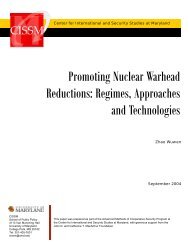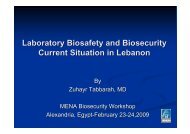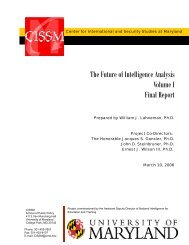A Reassurance-Based Approach to Space Security - Center for ...
A Reassurance-Based Approach to Space Security - Center for ...
A Reassurance-Based Approach to Space Security - Center for ...
- No tags were found...
You also want an ePaper? Increase the reach of your titles
YUMPU automatically turns print PDFs into web optimized ePapers that Google loves.
Executive Summary<strong>Space</strong> security has both military and environmental dimensions that need <strong>to</strong> beaddressed <strong>to</strong>gether through equitable rules that build on, but do not replace, the principlesand obligations in the Outer <strong>Space</strong> Treaty. In both dimensions, the central problem involvesa need <strong>for</strong> greater reassurance about how a growing number of state and non-state ac<strong>to</strong>rswill use increasingly sophisticated technologies that can have both beneficial and harmfuluses. On the military side, states want clearer and stronger protections <strong>for</strong> satellites beingused <strong>for</strong> legitimate purposes and corresponding protections against space being used <strong>for</strong>hostile purposes. On the environmental side, states want reassurance that other space userswill behave in ways that do not create more space debris or pose other unintended threats <strong>to</strong>their space activities. Both the general utility of arms control and the desirability of specificproposals look very different if the primary objective is <strong>to</strong> provide mutual reassurance, andnot <strong>to</strong> stabilize deterrence or <strong>to</strong> achieve a more favorable distribution of war-fightingcapabilities.Given the dual-use nature of most space technology, the core rules needed <strong>to</strong>enhance space security are more usefully defined in terms of legitimate behavior rather thanprohibited capability. A recent Canadian working paper proposes three very valuable rules,but leaves open several critical questions that cannot be answered with reference <strong>to</strong> existinginternational law or precedents from other arms control agreements. There<strong>for</strong>e, this paperproposes a different type of process <strong>to</strong> strengthen existing normative protections <strong>for</strong>peaceful satellites and prohibitions on weapons in space, and <strong>to</strong> promote more constructivenegotiations about additional rules and institutional arrangements <strong>to</strong> provide much neededreassurance. “Elements of a companion agreement <strong>to</strong> the OST” is provided in an annex <strong>to</strong>the paper, and sketches out potential elements of a comprehensive reassurance-based regimeas a stimulus <strong>for</strong> creative thinking about how different initiatives <strong>to</strong> enhance space securitycould be expanded and combined in<strong>to</strong> an integrated system.4







